Abstract
In Sudan, barley is mainly produced in limited areas in the northern states for grain and forage production. Barley is adapted to a broad range of agro-ecological environments such as drought, soil and water salinity and high temperature. In Sudan farmers usually grow a single local genotype (Beladi 46), despite its reasonable yield potentiality is susceptible to lodging. Accordingly, this study aimed at the exploitation of phenotypic variations among the barley (Hordeum vulgare L.) genotypes in Sudan for possible utilization in forage-type breeding programmes. In this context, an experiment was conducted for two consecutive seasons 2010/2011 and 2011/2012 at Gezira Research Station Farm (GRSF) and Hudeiba karu soil and one season in 2011/2012 at Hudeiba high terrace soil. The treatments comprised 20 genotypes of barley (including the check; Beladi 46). Those were arranged in a Randomized Complete Block Design (RCBD) with two replications. The parameters measured were days to 50% heading, plant height, No. of culms/m2, fresh and dry forage yield (t/ha), Crude Fiber (CF%) and Crude Protein (CP%). The results of the three sites, revealed very highly significant differences in fresh forage yield (t/ha) among the barley genotypes. Eight barley genotypes out yielded the check at each of the Gezira and Hudeiba Karu soil in season 2011/2012. Among those eight genotypes, the common genotypes in those two sites were G7, G9, G17 and G18 and out yielded the check by 15, 17, 19 and 28 % at Gezira site and by 22, 16, 43 and 23% at the Hudeiba karu soil, respectively. Genotype G17 out yielded the check by 8% at Hudeiba High terrace soil. In the five environments, genotypes G17 ranked first in two environments (Hudeiba high terrace soil and karu soil in season 2011/2012), G18 ranked first in Gezira and second in Hudeiba karu soil in season 2011/2012, G7 ranked second in Gezira and fourth in Hudeiba karu soil in season 2011/2012 and the local check (G20) ranked first in two environments in Gezira and Hudeiba Karu soil in season 2010/2011. Genotype G7 was the most stable genotypes with AMMI Stability Value (ASV) of 1.2 and with the mean fresh weight of 21.04 t/ha and G9 was the second stable genotype with ASV of 1.8 and with the mean fresh weight of 20.8 t/ha. The highest CP was obtained by G9 (16.6%) followed by G18 (13.2%) and G7 (13.1%). These results indicated the possibility of the development of forage-suited varieties of barley directly through further evaluation of those outstanding genotypes or indirectly through a crop breeding programme.
Keywords: Yield potential; Forage barley; Hot irrigated condition; Sudan
Abbreviations: AOAD: Arab Organization for Agricultural Statistics; GRSF: Gezira Research Station Farm; RCBD: Randomized Complete Block Design; CP: Crude Protein; CF: Crude Fibre; LTA: Long Term Average
Introduction
In Sudan, the area of rangelands and irrigated forages is estimated at 96 million and 30 thousand hectares, respectively [1]. The estimated dry matter production for animal feed is 104.80 million tons [2]. Due to degradation and desertification of rangelands in Sudan, the total dry matter production for livestock feeding is decreasing [3]. To cope with the increasing livestock numbers and the decreasing production in natural rangelands, production of high quantities of high-quality forage is considered imminent to minimize the huge forage gap in Sudan [4]. The contribution of irrigated forage crops is crucial to upgrade the animals for local and export markets. The increased demand for animal products and the great potential of the Sudan as forage exporting country has led to dramatic increase in the area devoted to forage crops especially around urban centers.
Up to date, only two types of forage (Abu Sabeen and Alfalfa) occupy around 95% of the area cropped to forage crops in Khartoum state (Statistics of the Ministry of Agriculture, Khartoum state, 2007). Abu-Suwar [5] and Khair [6] mentioned that alfalfa (Medicago sativa) is considered the top ranking (94 per cent of the total cultivated forage Sudan. The crop is exclusively grown underirrigation, particularly along the Nile from Khartoum state northwards. The area under alfalfa production is estimated at 52521hectare; however, the yield of the crop is relatively low (19.5ton ha-1 fresh matter) [5]. Hence, there is a pressing need to diversify the present production system with variable forage types and a high-yielding and highquality forage crop suited to Sudan’s condition. crops) among irrigated forage crops in
The canalization systems in all of the irrigated national schemes, necessitate that sizable area should be irrigated during the winter. Despite the availability of both irrigation and land, winter forage is currently not produced. In addition, large areas in the white Nile, Khartoum, River Nile and the Northern State are salt affected and hence require salt tolerant crops. Shortage of forages particularly during the summer on the other hand, imply that the alternative winter crop could be a forage crop.
Worldwide, barley (Hordeum vulgare L.) is the fourth most important cereal after wheat, rice and maize. Cultivated barley is a self-pollinating diploid species with seven paired chromosomes (2n = 2x= 14) [7,8], it is a winter and spring annual species with a short lifecycle [9]. Barley belongs to the family Poaceae (syn. Gramineae) and the tribe Triticeae [10]. Barley is grown for many purposes, but the majority of all barley is used for animal feed, human consumption, or malting [11-14] and also used for medical purpose [15]. The crop is adapted to a broad range of agro-ecological environments. Barley is a highly salt tolerant crop [16-20], the most drought and salt tolerant among the cultivated cereals [21] and also has a very good resistance to high temperature compared to other small grains [22].
In Sudan, barley is mainly produced in limited areas in the northern states for grain and forage production and farmers usually grow local genotype (Beladi 46), which have reasonable yield potentiality but susceptible to lodging. Thus, the objectives of this study were therefore, to explore the forage attribute-based variations among some genotypes of barley and to identify the top forage-yielding genotypes.
Materials and Methods
The experiment was conducted in five environments as follows: two consecutive seasons 2010/2011 and 2011/2012 in the Gezira and Hudeiba karu soil and one season in 2011/2012 at Hudeiba high terrace soil. Hudeiba Karu soil (HRSF) and Hudeiba High Terrace soil were located in Ed-Damer, River Nile State (Latitude 17o 34’ N, Longitude 33o 56’ E and Altitude 351m asl). The third site however, was in the Gezira Research Station Farm (GRSF), Wad Medani (latitude 14o 24’ N, longitude 33o 29’ E and Altitude 406.9m asl). The soil of the Gezira Research Farm is heavy, alkaline, cracking clay (clay 58%, pH 8.3, organic matter 0.02, nitrogen 0.25, phosphorus 0.06 and potash 3.0%).
The treatments comprised 20 genotypes of barley (including the check; Beladi 46) introduced from ICARDA and Islamic Republic of Iran. The treatments were arranged in a Randomized Complete Block Design (RCBD) with two replications, a plot size of 6 rows of 5 meters length each with a spacing of 0.2m between rows. In each season, the experimental sites were disc plowed, harrowed and leveled. The seed rate was 96kg/ha. The seeds were planted by hand after being treated with the insecticide Gausho (at the rate of 1.0g/1kg seeds) to avoid termites and aphids attack. The sowing date was in the first week of Dec. in Hudeiba karu soil and Gezira Research station in both seasons and in 30 Nov. in the Hudeiba high terrace soil. Irrigation was applied every 8-10 days in Hudeiba High Terrace site and every 10-12 days in both Hudeiba Karu soil and Gezira sites. The crop was hand weeded twice before fertilizer application. In addition, herbicide in the form of (2,4-D) was applied once at the tillering stage for the two sites in River Nile State. Nitrogen fertilizer, in the form of urea, was applied at the rate of 95kg/ha, once at the 2nd irrigation and once again at the 3rd irrigation. Phosphorus fertilizer, in the form of triple super phosphate, was applied only at Hudeiba High Terrace site at sowing. The net harvested area was 3.2m2 from each plot. When the crops reached milk stage, the parameters measured were plant height, No. of culms/m2 and fresh forage yield (t/ ha). Crude Protein (CP) and Crude Fibre (CF) was determined as percentage of dry matter in the feed analysis laboratory at Elobeid Research Station, ARC according to the analytical methods used by the AOAC, [23].
Statistical analysis was done using GenStat software. The statistical procedures used for the stability analysis of genotypes was AMMI Stability Value (ASV) as described by Purchase [24]. The equation of ASV as follow:
Gorkha District lies in an altitude of 1106m (3628.609ft) from sea level which has Sub-tropical climate zone and has latitude of 28°3′.372″ N and longitude of 84°37′.432″ E with elevation of 488- 8166m respectively. Shree Hanumaan Multipurpose Agricultural was selected as a registered climate smart applier under DoEnv. According to NAPA document 2010 Gorkha was ranked as high (0.601-0.786) to an overall climate vulnerability index (Figure 3).

Results
The growth of barley in both seasons progressed normally with no incidence of insects or diseases.
Climate
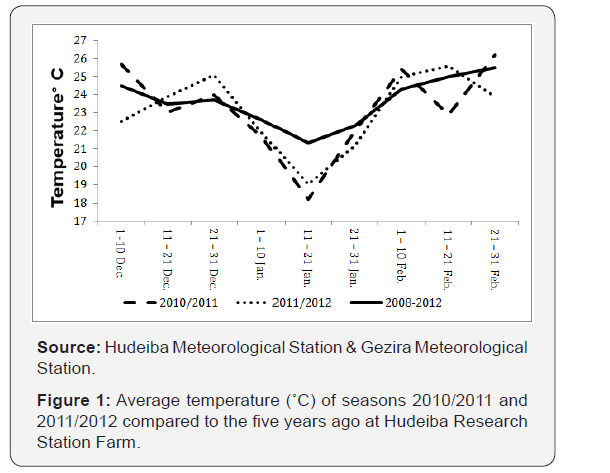
The mean temperature prevailed during the growing periods of seasons 2010/2011 and 2011/2012 were shown in Figure 1 &2. The mean temperature of the first season was lower than that of the second season from mid Dec. to mid-January and from first Feb. to mid Feb at Hudeiba sites (Figure 1). Also, the mean temperature of the first and second seasons were lower than the mean for five years prior to 2012 at Hudeiba sites. At Gezira site the mean temperature of the first season was higher than the second season from first Nov. to mid Dec., in contrast, the first season was lower than the second season from mid Dec. to mid-February. Compared to Long Term Average (LTA), the mean temperature of the January in the first season is lower than the second season (Figure 2).
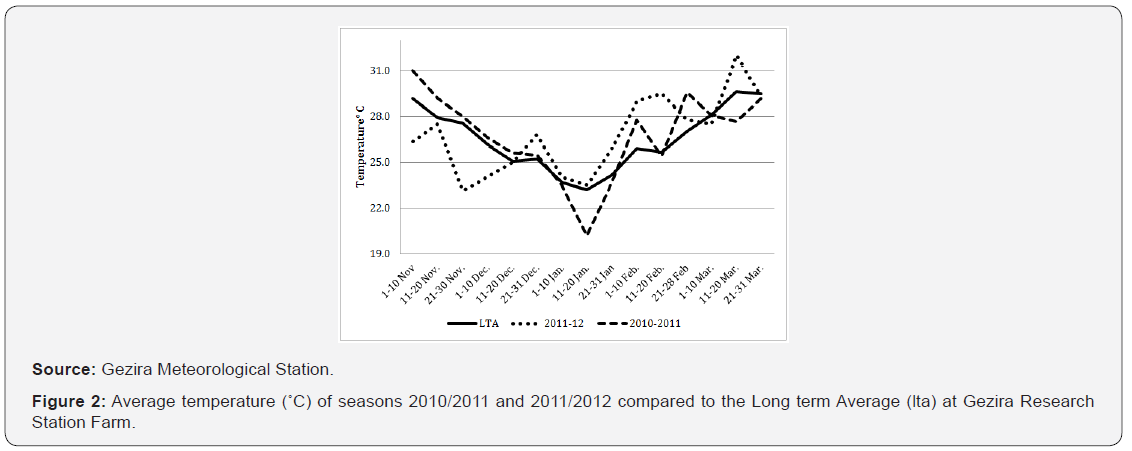
Fresh forage yield (t/ha)
Differences among the fresh forage yields of all genotypes were highly significant (Table 1). In fact, the highest yields in the three sites ranged from 28.34 to 28.52t/ha and the lowest ranged from 4.15 to 8.13t/ha in 2010/2011. Similarly, in 2011/2012 the highest yields ranged from 20.25 to 29.82 t/ha, while the lowest yields ranged from 7.08 to 15.5t/ha (Table 2). The fresh forage yield of all barley genotypes was surpassed by that of the local check in season 2010/2011 at both Gezira and Hudeiba karu soil. In contrast, eight barley genotypes out yielded the check in season 2011/2012 at both Gezira and Hudeiba karu soil. The common genotypes across those two sites were G7, G9, G17 and G18 and out yielded the check by 15, 17, 19 and 28%, respectively at Gezira site, while at karu soil by 22, 16, 43 and 23%, respectively. The genotype G17 out yielded the check by 8% at Hudeiba high terrace soil.
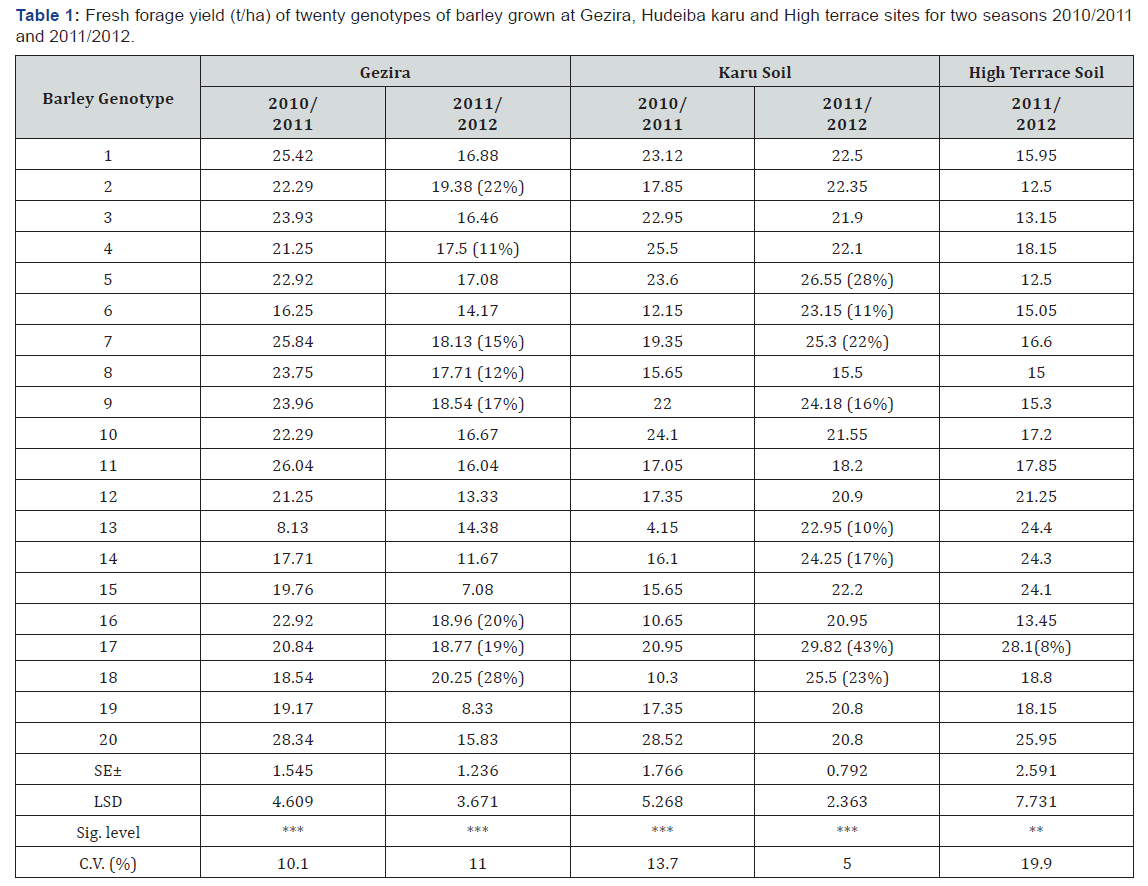

Among the barley genotypes, the AMMI analysis revealed that, fresh forage yield was significantly (P≤0.001) affected by genotypes (G), environment (E) and their interaction (GEI) (Table 3). Based on the total treatments sum of squares, 24%, 20% and 56% of the variance was due to E, G and GEI, respectively. The GEI was partitioned into first and second interaction principal components axis (IPCA1 and IPCA2). The IPCA1and IPCA2 were very highly significant and their contribution to the total GEI sums of squares were respectively 55% and 29% (Table 3).
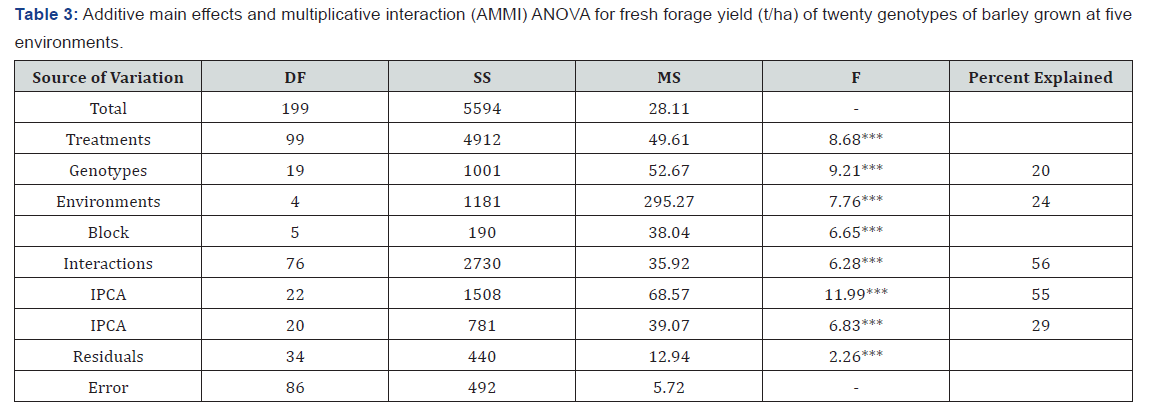

According to AMMI Stability Value (ASV) of fresh weight, G7 was the most stable genotypes with ASV (1.2) and with the mean fresh weight (21.04t/ha), G9 was the second stable genotype with ASV (1.8) and with the mean fresh weight (20.8t/ha).In contrast,G17 was the most unstable genotypes with ASV(2.8) and with the highest mean fresh weight (23.7t/ha) and G18was second to G17 with ASV (2.9) and with the mean fresh weight (18.68t/ha) (Table 4).
Among the five environments, the genotypes were arranged according to AMMI estimate (Table 5). Among the genotypes, G17 ranked first in two environments (karu soil and high terrace soil in season 2011/2012) and G18 ranked first in Gezira and second in karu soilin season 2011/2012.G7 ranked second in Gezira and ranked fourth in karu soil in season 2011/2012.While, genotypes G9 ranked fourth and fifth in the Gezira in both seasons (Table 5).

Among barley genotypes, the GGE scattered biplot analysis showed that 86.85% of the variance was due to PC1 (57.51 %) and PC2 (29.34%) (Figure 3). The five environments were divided into three mega environments. The first mega environment included Gezira and Hudeiba karu soil in season 2010/2011. The second mega environment included Hudeiba high terrace soil and karu soil in season 2011/2012. The third mega environment included Gezira in season 2011/2012. The local check (G20) waswinning at the first mega environment, while G17 waswinning at the second mega environment and G3 and G9 were winning at the third mega environments.
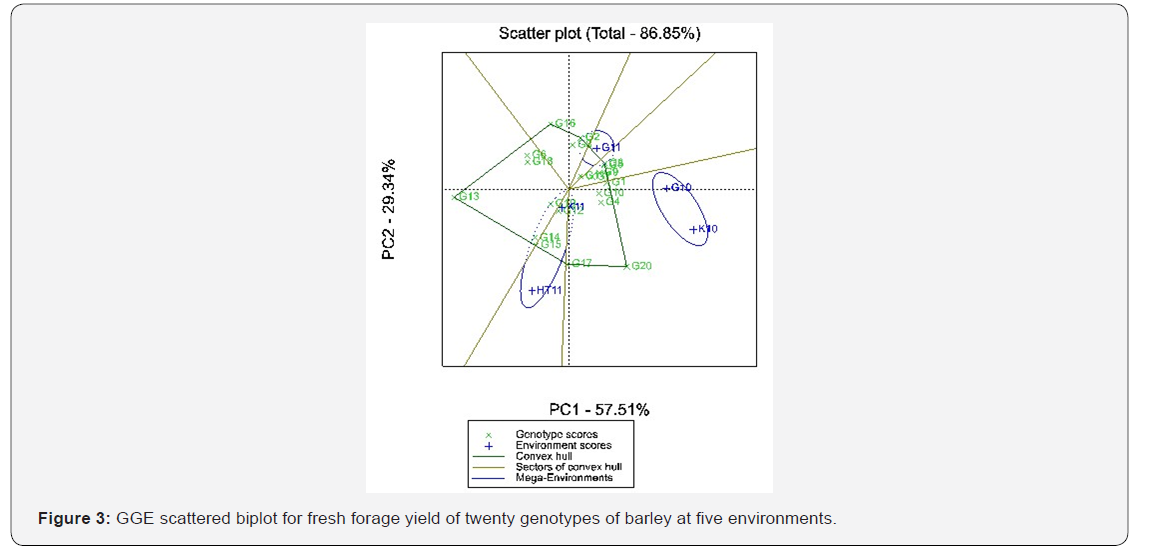
Days to 50% heading

The variability on days to heading ranged from 53 to 88 days at Gezira, from 56 to 102 days at karu soil and from 53 to 89 days at high terracesoil (Table 2). Among, the top yielding barley genotypes, the genotypes varied considerably in attaining the stage of 50% heading. Genotype (G9) and G20 (check) were earlier than (G7) and (G17) at the three sites (Gezira and Hudeiba high terrace soil and karu soil). Generally, G18 was the latest in attaining 50% headingat the three sites (Table 6).
Plant height (cm)
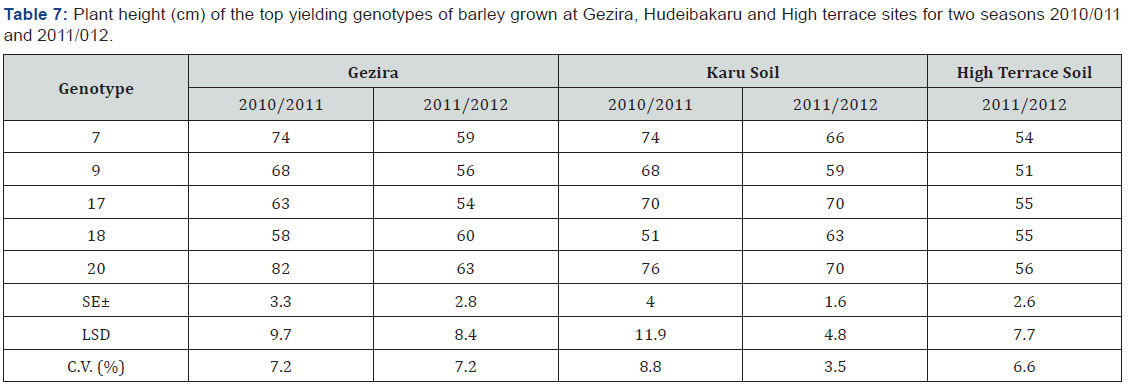
Wide variations were observed among the plant height of the genotypes. The plant height ranged from 39 to 82 cm at Gezira, from 39 to 76cm at karu soil and from 45 to 68 cm at high terrace soil (Table 2). Apparently, the tallest plants were associated with the first season, whereas the shortest plants were associated with second season in the Gezira and karu soil. Generally, among the top yielding genotypes, the local check (G20) was the tallest genotype in the three sites (Table 7).
Number of culms/m2
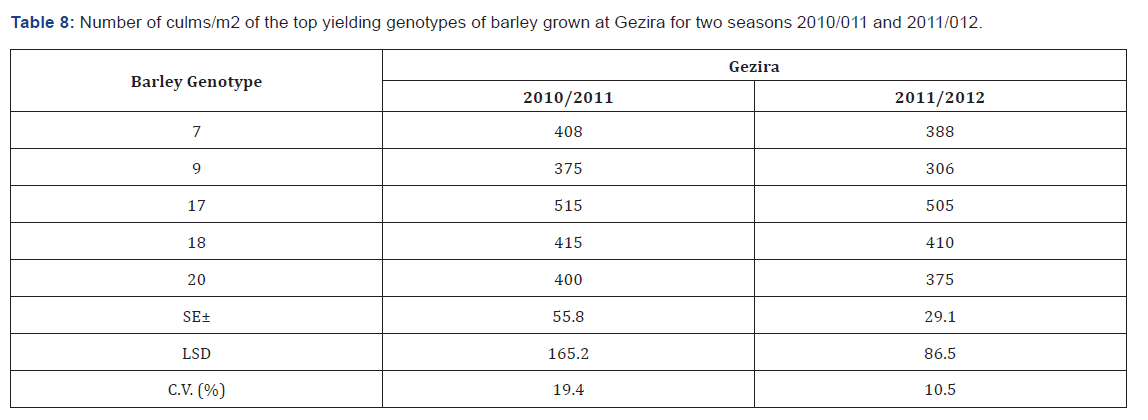
The culm density denotes the sum of the plant density and the tillers density. The data of number of culms per meter square was not taken at Hudeiba high terrace soil and karu soil in both seasons. Regarding the genotypic effect, the number of culms per meter square ranged from 220 to 668 at Gezira (Table 2). Among the top yielding genotypes, the highest number of culms was obtained by genotypes G17 and G18, while the lowest number of culms was obtained by genotypes G9 and G20 (check) in both seasons (Table 8). The differences in the number of culms of the top yielding genotypes were not significant in the first season and highly significant in the second season.
Forage quality
The studied barley genotypes differed in Crude protein (CP%) and crude fibre (CF%) (Table 9). The Crude Fibre (CF%) ranged from 32.6 to 40.8, while the crude protein (CP%) ranged from 9.9 to 16.6. Among the top yielding genotypes, the highest CP percentage was obtained by G9 (16.6%) followed by G18 (13.2%)and G7 (13.1%), whereas the lowest (CF%) was obtained by G20 (35.7%) followed by G7 (36.1%) and G18 (36.6%). On the other hand, the highest crude protein yields (3.5,3.1, 2.9 and 2.8t/ha) were obtained by genotypes G9, G20, G17 and G7, respectively, while the lowest crude protein yield was obtained by genotype G18 (2.5t/ha) (Table 9).
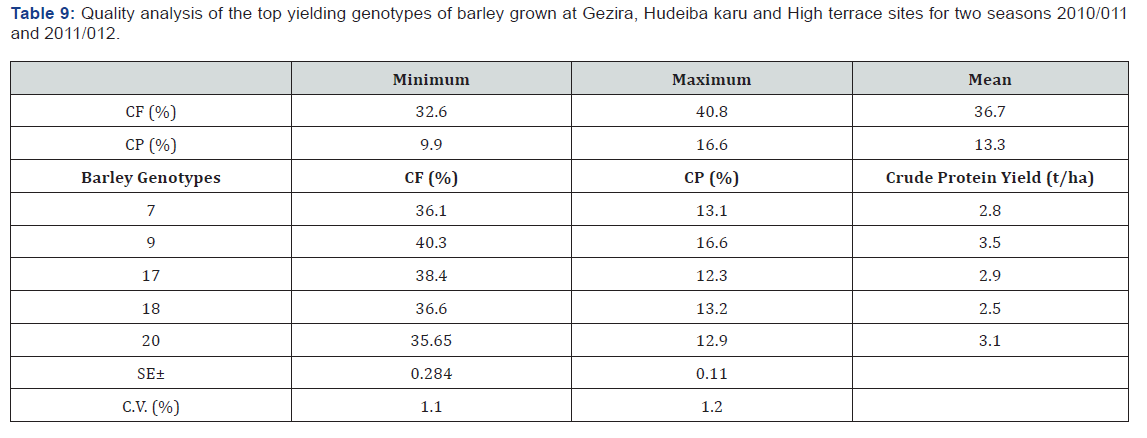
Discussion
Based on the temperature data presented in this study, Sudan seems to be highly marginal for the production of wheat and barley. The progressive successes in wheat production in Sudan however, suggest that similar successes could be achieved in barley. This is highly plausible based of the highly adequate performance of forage barley which was exhibited in the earlier studies in the Gezira [25,26].
As a rule of thumb, the combination of high biomass yield and forage quality are the most two important attribute of a good forage crop. In this context, the data of the biomass and crude protein in this study presents strong ground for selection among the tested genotypes. The seasonal differences among the fresh matter yield of the genotypes could be attributed to variation in temperature. In fact, the average temperature of season 2010/11 were slightly lower than those of 2011/12 at Gezira and Hudeiba sites. Despite that, the adequate performance of a number of genotypes in 2011/12 in both sites reflects that the temperature of 2011/12 was not detrimental for the production of forage barley. The study showed four highly yielding genotypes to be common in both sites in 2011/2012. This reflects the possibility of finding stable good yielding genotypes to be released as varieties. Those genotypes were G7, G9, G17 and G18 which out yielded the local check by 15, 17,19 and 28%, respectively in the Gezira and by 22, 16, 43 and 23% in Hudeiba karu soil. Furthermore, the fresh forage yields of those four genotypes were higher than those reported by Khair et al. [25], Salih et al. [26], Alazmani [27] and Bouzigne et al. [28].
By virtue of being a C3 cereal crop, barley forage is expected to be highly nutritious crop. This is because kranz anatomy which render the tropical grass less nutritive is lacking in barley. Even within the C3 cereals, barley is reported to be of greater nutritive value and less fibres than wheat and triticale [29,30]. Cherney and Martin [29], associated the higher forage quality of barley with greater proportion of inflorescence in it is total dry matter [31].
In the current study, among the top yielding genotypes, three had CP% higher than 13% and three had CF% lower than 36.6%. Two genotypes viz, G7 and G18 were advantaged by having highest CP% and lowest CF%. The CP and CF of those genotypes were little lower than those of the tropical legumes i.e. lubia, clitoria and phillipesara harvested at 70 days of age [6] except the genotype G9 which had highest CP% and CF% (16.6% and 40%, respectively) than the tropical legumes. In contrast however, the CP% of barley in this study and of earlier reports [25] were by far higher than those reported for Abu Sabeen in summer [6] and in winter [25] and higher than those reported for barley [25,26,28]. The CF% of barley in this study are lower compared to those of Abu Sabeen in winter [25]. This might necessarily indicate that the digestibility of barley would be higher than those of Abu Sabeen. The maintenance of such high quality could be attributed to the fact that the plants were fairly short (<75cm) and the leaves had constituted a considerable portion of the dry matter.
Conclusion
a. The study is further consolidation to the fact that barley could be a good forage crop in Sudan.
b. Phenotypic variations among the barley genotypes studied here are well verified.
c. The prevalence of some common genotypes (based on fresh matter yield) is clearly pin-pointed.
d. The results indicated the possibility of the development of forage-suited varieties of barley directly through further evaluation of those outstanding genotypes or indirectly through a crop breeding programme.
https://juniperpublishers.com/artoaj/index.php
To Know More About Open
Access Journals Publishers Please Click on: Juniper
Publishers




No comments:
Post a Comment